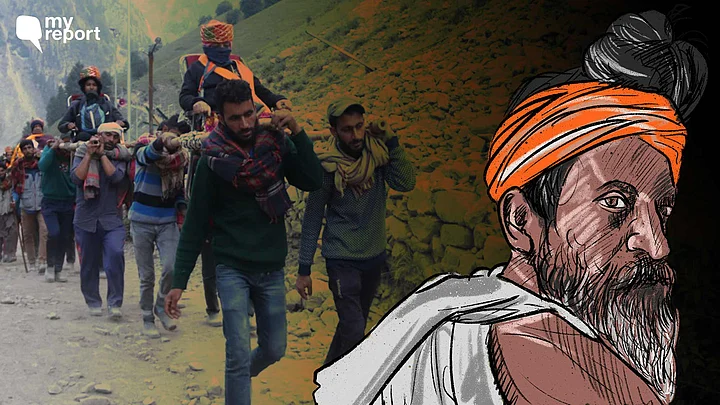The news of Amarnath Yatra resuming this year got me very excited, and I wanted to be a part of the media crew that went to cover it. It's been three years since the yatra was suspended. In 2019, the central government called it off in the wake of the abrogation of Article 370 in the erstwhile state of Jammu and Kashmir, and then in 2020 and 2021, owing to the pandemic, the pilgrimage was barred again.
Fifteen days before the yatra was supposed to begin, the Amarnath Shrine Board asked mediapersons to submit a form, which included details of a medical checkup from a recognised hospital and a police verification. But this wasn't the case before; earlier, journalists could apply to the board and directly get permissions/passes.
The Yatra Begins!
At around noon on 29 June 2022, my colleagues and I left the press enclave in Srinagar. It was a bright, humid day, and we were doubtful if we would be allowed to enter the Baltal base camp in Sonamarg. This year, we received only a verbal confirmation to cover the yatra. The number of passes was limited, and most of them were issued to acclaimed international news agencies.
En route, security forces, the Jammu and Kashmir Police, CRPF, and the ITB were patrolling from Ganderbal road to Baltal base camp.
My name wasn't on the official list, but I had submitted a form to the shrine board. A few restrictions were imposed on the media on the first day of the yatra. After that, being a valid mediaperson was enough to cover the event.
The second we reached Sonamarg, the police stopped our vehicle at a checkpoint. I saw hundreds of pilgrims, men and women, waiting in long queues to get their passes confirmed.
Our bags and cameras were scanned, and after identity verification, we were allowed to move forward towards the Baltal base camp.
'Bum Bum Bole' & 'Barfani Baba ki Jai'!
At around 4:30, we reached the base camp. I saw hundreds of vehicles parked. No vehicle was allowed to move beyond the Baltal checkpoint. Therefore, pilgrims were carrying their bags on their backs. Only people with passes were heading towards the camp.
It was the first time in my reporting career that I was covering the famous Amarnath Yatra. Everything around me felt different and unique. I found pilgrims chanting "Bum Bum Bole" and "Barfani Baba ki Jai."
Here, at the base camp, hundreds of tents and makeshift stalls were installed. Bhajans were being played through huge loudspeakers. The base camp was populated with food stalls and a temporary free kitchen.
Tourism Industry Affected
We were finally walking towards Dumail, where in the wee hours of the morning, the pilgrims or yatris would be allowed to make their way towards the holy cave.
Locals provide palanquins, tents, and mules to the pilgrims – a part of their livelihood.
"Over the last two-three years, we had faced a lot of problems. Tourists and pilgrims were not allowed to come here due to the COVID-19 restrictions. We had no business."Ishtaq Ahmed, Tent accomodation work
The locals were thrilled that the yatra was resumed this year and they could earn their bread and butter. The stories shared by pony walas were no different.
As I walked, I started recording visuals of pilgrims who had just arrived at the camp. They were waving at me. Jostling through the crowd, I began speaking to a few pilgrims.
"We couldn't visit the shrine in the last three years due to the abrogation of Article 370 and the COVID lockdown. Now, we are happy. Finally, we made it this time," a pilgrims said.
In the evening, my colleagues and I sat down and enjoyed a warm cup of tea while talking about everything else that's happening in the country.
With the sound of water flowing down the stream, I fell asleep at around 1 am in my tent, only to be woken up by 3:30 in the morning to see the beautiful, pristine landscape. I saw pilgrims on horsebacks and being carried on palanquins.
We quickly got ready and left for the trek. At around 5:30 am, we reached the Dumail checkpoint. There was a sea of pilgrims and pony walas in the area., dropping off pilgrims, picking up new ones.
Soon, pilgrims were allowed to move towards the mountainous terrain and I was following them.
Everything around me started moving in slow motion. I tried to walked on the narrow path along with the pilgrims, recording visuals, clicking pictures, and talking to some who were resting on the side.
Security forces were guarding the mountainous terrain, cautioning pilgrims against walking on the edges.
After getting enough photos and walking for a few kilometres, we decided to head back to the tent. It took us two hours to reach our tent.
Upon reaching, I had a cup of tea to recharge myself. I was lost in thought; the entirety of the yatra felt like a surreal experience.
(All ‘My Report' branded stories are submitted by citizen journalists to The Quint. Though The Quint inquires into the claims/allegations from all parties before publishing, the report and the views expressed above are the citizen journalist's own. The Quint neither endorses, nor is responsible for the same.)
(At The Quint, we question everything. Play an active role in shaping our journalism by becoming a member today.)
